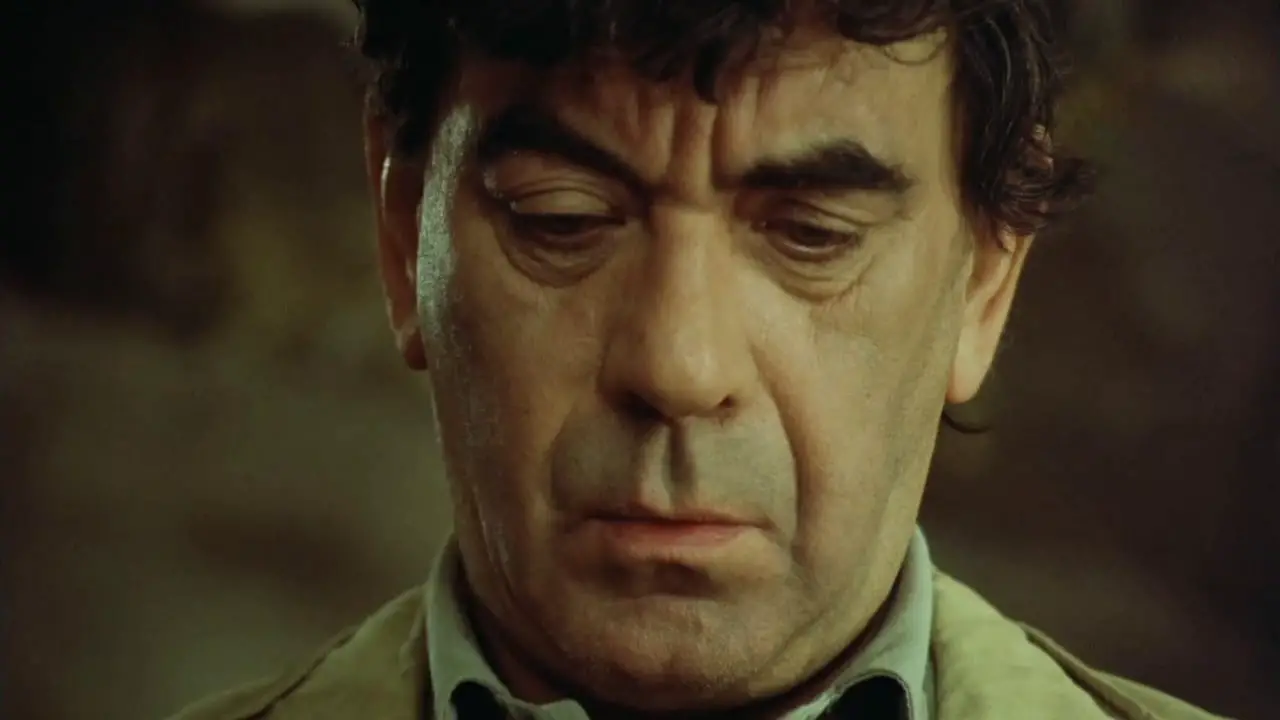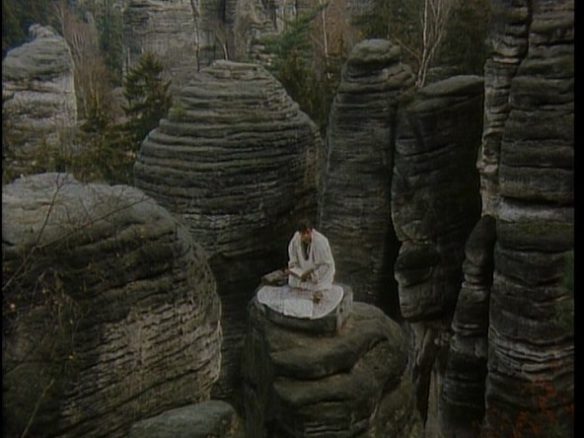It is one of the most famous and resonant myths across the centuries. The tale of the man who sells his soul to the devil in exchange for unlimited access to the highest realms of knowledge and pleasure still resonates because it speaks to the fundamental human attribute of desiring what it cannot truly have, and how far one will go to satiate that desire. One only has to look at the voters who turned to Trump as an answer to their frustrations as a version of the Faust scenario in play.
The tale has been retold many times, like a folk story that takes on new details and new meanings dependent on the teller and the time in which it is told. Famous examples include Charles Gounod’s Faust libretto and Hector Berlioz’s opera La Damnation de Faust, F.W. Murnau’s silent Faust film, Christopher Marlowe’s The Tragical History of Doctor Faustus and, perhaps most famously, Johann Wolfgang von Goethe’s epic poem Faust.
And then, in 1994, there was Jan Švankmajer…
An Artist and a Realised Dream
A self-defined Surrealist and one-time member of the Czechoslovak Surrealist Group, Švankmajer is a celebrated filmmaker and stop-motion artist, working particularly with clay to create a combination of grotesquery and fluidity of movement that allows for imaginative scenarios and an irrationality of action, as favoured by Surrealists. As could be expected of a man who would use a regular motif of a stop-motion tongue crawling across a floor in one of his films, he is known for having a gloriously bizarre sense of humour, which transfers to his films.
One of the major themes that seem to preoccupy Švankmajer’s feature films is the disruption of a person’s rational sense and the consequences of this, whether positive and negative. Conspirators of Pleasure explores how people are unable to express their romantic or sexual feelings in a “normal” or standard manner and resort to expressions that distort their image and the image of others (fashioning oneself into a chicken, stuffing one’s ears and nose), which in turn disrupts their sense of socially correct behaviour and even the rules of existence (sexual arousal from fish; an effigy killed by a boulder mirrored in its real-life counterpart also being killed by a boulder).
In possibly Švankmajer’s most famous film, Alice, his retelling of the Alice in Wonderland story, he shows the empowerment that can come from the disruption of the senses, as Alice awakens from her dream to find herself sufficiently strong and decisive to take action against the white rabbit that had tormented her. “I think I’ll cut his head off,” she smiles as she brandishes a pair of scissors. Her experience in Wonderland has arguably made her a stronger person.
Commenting on Alice, Švankmajer defined a quality in the work that, as we’ll come to see, is central to Faust:
While a fairy tale has got an educational aspect – it works with the moral of the lifted forefinger (good overcomes evil), dream, as an expression of our unconscious, uncompromisingly pursues the realisation of our most secret wishes without considering rational and moral inhibitions, because it is driven by the principle of pleasure. My Alice is a realised dream.
As we shall see, Faust is also a realised dream.
A Faust Among Many
Whilst it cannot be said that Švankmajer’s Faust is without a moral (it is hard to avoid one when dealing with such a weighty topic as a man selling his soul to the devil), the film uses dream logic and circular narrative to suggest Faust’s downfall is inevitable, whilst allowing the audience enough space to judge whether Faust is right or wrong in his motivations to sell his soul.
In fact, the film leaves the character of Faust very much a blank canvas for the audience to project their own ideas onto him. We are not told of his motivations until he negotiates his deal with one of the devil’s minions (fixed to look like Faust himself), while we see very little of his life beforehand to deduce much about his character.
The Faust of popular myth was an intellectual and scholar who became bored with what he had learned and the limits this had imposed upon him. In Marlowe’s tale, it is Faust’s excess of hubristic conceit, compared to Icarus flying too close to the sun, that spurs him on. In Goethe’s version of events, it is the failure of knowledge and learning to live up to their lofty statuses as explainers of existence that gnaws at him. Both want infinite knowledge and the pleasures and power this will bring.
What can we say we know about Švankmajer’s Faust? We know nothing really of his past, his career or his personal life. But we can surmise a few things from what we’re shown. Whereas Marlowe’s and Goethe’s Fausts were scholars and intellectuals and had some kind of position, this Faust appears to be down at heel and of no importance. He is dressed dully and shabbily, like a civil servant. He lives in a small, cluttered and messy apartment that contains a chicken that has defecated all over the floor (and runs off when Faust enters the apartment at the start of the film).
We can also assume that he is short of money, as he scrapes together a scrappy meal of bread and mango. He regularly seems to find a great big stein of beer to sip from. All in all, Švankmajer’s Faust appears to be living a malnourished, seedy kind of life.

It is not the worst possible existence, but it is the dusty pit of the make-do, monotonous existence that boredom breeds most excessively. It is easy to see why a man like this would want to sell his soul to the devil for some kind of improved condition of living. And that’s exactly what he will do.
All Is Not What It Seems
The film begins with Faust symbolically emerging from the underground Prague Metro, out from the bowels of the earth (or out of the depths of Hell) and into the street, where two men are giving out maps to passers-by that have a location marked with a red dot. We don’t know what the red dot is indicating at this point, as there is no writing on the map other than street names. Indeed, Faust takes a derisory look and crumples the map up, throwing it away. But the two men will remain, throughout intervals in the film, within Faust’s orbit; in the pub, at the theatre, serving at a restaurant and giving Faust the ability to produce wine from the middle of his table for free. They are always watching.
To look at, the two men are nothing extraordinary. One has shoulder-length hair, the other a moustache. It is this ordinariness that makes them dangerous, for they are not any old hawkers on the street. They stand under Faust’s window as he finds another copy of the map inexplicably in his drawer, and lightning strikes the ground. They look up at him with milky, film-coated eyes, which they eventually take out, revealing them to be a kind of haunting decoration or cover. Appearances are not what they seem, and all that glitters is not gold.
Whatever the impact of the lightning, the coated, haunted eyes, and the new map, Faust decides to visit the location marked by the red dot. There is perhaps a case to be made that Faust intuitively understood what the map was leading him to once he saw it again, and that the watching men and the lightning are indicative of this. There is also a case to be made, which I will return to, that Faust is simply following the path that is laid out for him with a sense of inevitability. In any case, the film allows the audience enough room to draw their own conclusions.
The location itself also adheres to the motif here that things are not as they first appear. From the outside, it appears to be just an everyday, run-of-the-mill tenement building. But inside is a labyrinth of dishevelled courtyards, shadowy corridors and the occasional impassive face staring with indeterminate intention. It is here that Faust will encounter both Mephistopheles, the devil’s minion, and indeed the devil himself.
Interestingly, it is here that Faust will also encounter the echoes of the other retellings of this myth.
The Tragic History of Doctor Faustus
Senses of Cinema described the film as “a collage; fragments from plays, old Czech puppet productions and opera.” While it is true that the film doesn’t use just one of the Faust stories as its template, it is fair to say that the film leans far more on Marlowe’s The Tragical History of Doctor Faustus than on other variants.
In the film, whilst exploring the red-dot location, Faust finds an actor’s theatre dressing room. Whilst there he finds a script of a “Faust” monologue, a beer, and a costume which, once adorned, puts us in mind of a classical actor of Marlowe’s era in the 16th and 17th Century. Faust reads from the script and even finds himself on an actual stage in an actual theatre (a strange thing to find in a tenement!) These seem to be gentle nods to Marlowe’s play using a gently self-referential posture.
Faust escapes from the stage and finds himself encountering an angel and demon in the form of marionettes. They will make their arguments as to whether Faust should seek forgiveness and salvation in the Lord, or infernal ecstasy with the devil at the cost of his soul. This echoes Marlowe’s play, where Faust is subject to the arguments for and against by a devil and an angel.
The length of time he specifies that he wants the devil’s assistance, 24 years, also matches Marlowe’s play, whereas in Goethe’s version, Faust specifies he wants the devil’s assistance until he should pass away (which seems a better deal to me), although he includes the curious caveat that if he should find himself in a perfect moment, he is happy to die and for the devil to take his soul right there and then.
Furthermore, when Faust attempts to claim Mephistopheles’ services for his own, Mephistopheles claims he cannot do so, as he is bound to the service of Lucifer. However, a deal is brokered with Lucifer for Mephistopheles to serve Faust for 24 years, at which time Lucifer will claim Faust’s soul. This bartering is also taken from Marlowe’s Faust tale.
The one thing Švankmajer does bring to the table that previous tellings couldn’t is his interpretation of the story as a dream.
Dreams of Pleasure, Power, and Chickens
At the beginning of the article, I gave the following quote from Jan Švankmajer: “…dream, as an expression of our unconscious, uncompromisingly pursues the realisation of our most secret wishes without considering rational and moral inhibitions, because it is driven by the principle of pleasure.”
With Švankmajer’s rendering of Faust, I believe he was again tapping into the idea of the dream, but the driving principle was not just one of pleasure but rather of power also—the power of knowledge. Faust does not consciously realise this, but he is not making his choice to sell his soul to the devil from a moral standpoint, but rather to satisfy a heavily frustrated desire. But to communicate Faust’s unconscious pursuit of this desire, Švankmajer had to relay the film to the audience as if it was indeed a dream, Faust’s inner canvas playing out his heart’s desire in a heightened form to see if its realisation is at all likely.
Quite suitably for a surrealist, the film uses disruptive imagery and editing to give the impression that we are in fact watching a dream. There are certain images and peripheral aspects of the film that are not explained and disrupt any status quo or social order of a perceived “reality” as would be presented by a more mainstream film. Why does Faust have a chicken in a city-centre apartment (that people chase in the street when it escapes)? Why is there a whole egg, shell still intact, evidently baked into the middle of Faust’s loaf of bread that, once cracked, reveals itself to be empty and ushers in the lightning? Why is there an active theatre, complete with chorus line, stagehands and audience, in the bottom of a tenement building? And why the hell do we get not one but two glimpses of what appears to be a marionette sitting on a public toilet? These images, by their nature irrational and even nonsensical, disrupt our standard expectations of a standard cinematic representation of reality and add to the surreal, dreamlike feel of the film.
Taking this dream feel even further, Švankmajer uses editing to seamlessly move Faust from location to location without it seeming like he has even left the room. Early in the film, Faust uses the restroom at the theatre, and when he returns, he finds himself standing in a crowded restaurant where the two map-bearers are eating a meal and watching him. He returns to the bathroom to find another door that leads him up a dirty, cobwebbed stairwell, which in turn takes him to an overlarge attic looked down upon by rows of lights. We are evidently not in Kansas anymore.

When Faust begins his ritual to summon the devil, he is assaulted by a row of brushes sweeping dust all over him. When he brushes the dust off, he finds he is in a dark and gloomy wood, the transition made with a simple, seamless cut. Clay hands beat a drum as Faust continues, and as the drums beat unbearably louder, Faust turns around to find he is facing the cellar again, where a group of anonymous arms are pointing crossbows at him. Through the use of reaction shots we can see Faust is still in the wood, so does the cellar open onto the wood, or is Faust able to contract and see across space to bring two distant places together? Faust ducks as the arrows circle him and appears to be kneeling on the wooden floor of the cellar, and yet when he stands up we move from a quick closeup to a long shot showing Faust standing on a large pillar of rock, perilously close to slipping off the edge in the gap between him and the surrounding rocks just out of reach. It is these sudden yet seamless leaps in location that really give the film a feeling of traversing a dream.
A Circular Verdict
If we can argue that the dream is Faust’s subconscious playing out the likely success of being able to obtain his heart’s desire, what conclusion does his subconscious reach?
The film makes clear that the verdict is negative. Pleasure can be attained, but the knowledge Faust seeks is even beyond the scope of the devil and his minions. Faust, disappointed that he has still not attained what he is after, states, “So I still seek the force that guides life flow, something more than life’s external show.”
Mephistopheles makes the feasibility of such a goal clear: “This force cannot be known…(it) lies beyond what words address. We only grasp those thoughts which language can express.” Faust retorts, “Then what of longing or affection? All those feelings that rage within us like a storm at sea.” Mephistopheles is not impressed: “(They are) only mist…your thirst for knowledge is unnatural. Live as millions of your brothers do. Sleep, eat, drink…let that suffice for you.” This, of course, is what Faust wants to avoid. He wants to transcend the drudgery and monotony of mere existence.
Faust asks Mephistopheles, “Where are the pulse and core of Nature you promised to reveal?” Mephistopheles answers now with a remark which shows that he does not condemn man to drudgery but believes man is too ignorant to be truly enlightened. “You lack the wit,” he tells Faust, “to see them in every blade of grass.” It is here that Faust ultimately seals his fate. “Now I know that the devil knows no more than we.” By saying such, Faust is only confirming Mephistopheles’ argument of humanity’s ignorance: “The man who turns to Satan in his search for peace, however he may see it, is a fool indeed.” And yet there is a case to be made that Faust did not have completely free will when it came to his error; he was in fact possibly fated to it.
Jan Švankmajer has eluded to this elsewhere: “I do believe that man is, in a certain way, determined. I am convinced that we are still manipulated—by the stars, our genes, by our repressed feelings, by society, its education, advertising—repression of all kinds.” Here, Faust’s fate is determined by his own subconscious, which is communicating in dream form that humanity is doomed to make the same mistakes over and over if it follows its own hubris continuously.
To demonstrate this, Švankmajer interjects a circular narrative into Faust’s dream, a neatly ironic reference to Dante’s circles of Hell in his Inferno, and which shows the damnation of man as a continuous loop to be played out with fresh protagonists each time.
It is clear that the two map men from the start of the film are procurers of souls for the devil and lead Faust off on his path. As Faust travels to and enters the red-dot location, there are two warning signs that will pay off by the film’s conclusion. The first is a red car that seems to be looping around the block. Faust narrowly misses being hit, but he was not at risk of being hit at that point anyway. That was to come later. The second thing he sees is a man running through a corridor in the tenement, past him, and out through the door as if trying to get to the exit, back to the street so he can make a snappy getaway. Faust should have joined him. When he finally does run, his fate has been sealed.
At the film’s climax, Faust is tricked into making love to a marionette(!) which he believes is the great Helena but turns out to be a demon in disguise. This is a punishment for the disrespect Faust has shown Mephistopheles and the devil. The devil appears and tells Faust, “When midnight strikes, your body and soul are mine.” Faust plans to renege on his agreement with the devil, and it is arranged for two marionette tough guys to watch Faust’s door and prevent the demons from entering to take him away. The demons, of course, do gain entry to Faust’s room after burning the two marionette guards. But Faust has already gone, having snuck out the back door and back up the stairs, across the courtyard and into the corridor. There we see a man entering at the other end, cautiously looking around with map in hand. Faust runs past him in panic, and the penny drops: Faust has become the man who had run past him previously. The circle is nearly complete. The new man watches Faust for a moment before continuing on, unknowingly walking into his own damnation.
Faust begins to run across the road, but the devil is in the detail. And the detail here is the red car, having made another loop of the block, appearing and running Faust down, his arm and his leg sticking out from under the vehicle, a stream of blood running into the road as the two map men watch happily. A policeman checks the car, but there really was no need. There is nobody in the vehicle. The devil always gets his man.
But as Švankmajer’s Faust teaches us, the devil only gets us because we allow him to.



